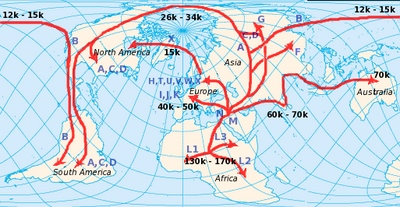
Human ancestry turns out to be far more widely dispersed geographically and far more varied than previously thought.

Age in thousands of years where there is DNA evidence for divergence among humans.
“variability affects not only visible characters, but also physiological traits, patterns of behavior, aspects of ecology (adapting to climatic conditions), and molecular patterns, all of this reinforcing the conclusion that in one way or another every individual is unique."
"variability affects not only visible characters, but also:
http://www.archaeologyinfo.com/species.htm
This evidence is "reinforcing the conclusion that in one way or another every individual is unique."
"One can never fully understand the process of evolution unless one has an understanding of the basic facts of inheritance, which explain variation. Therefore the study of genetics is an integral part of the study of evolution. But only the heritable part of variation plays a role in evolution."
Human Descent
The Earliest Human Ancestors: New Finds, New Interpretations
Dr. Becky Rogers Ackermann,
Department of Archaeology
University of Cape Town
"The third discovery of 2001 does not name a new species - only a new subspecies, for now - but does extend the known existence of Ardipithecus ramidus significantly back in time to 5.5 mya. Ardipithecus ramidus kadabba, announced July 2001 is from the Middle Awash, Ethiopia. In the paper describing this find, the author claims that Orrorin was not well evaluated, and that A. ramidus kadabba is truly the earliest human ancestor, representing the true human lineage. But there is a blanket of uncertainty over all three of these 2001 finds, as we no longer know what an early hominid should look like. Should it have thin enamel or thick? What is derived, and what primitive? Who do we believe?
Where do we go from here?
What we have learned in the last eight years is that our theories about early human ancestry are anything but set in stone. Any of these new fossil finds are poised to alter our understanding of early human ancestry. They have already extended the breadth of our knowledge both in geographic space and evolutionary time. Will they offer more?
But what is becoming increasingly clear is that we are dealing not with a family tree, but with a bush.
Or as Darwin proposed - I think more appropriately - a coral, where the base of the coral is long dead, and only the tips live on.

References and Further Reading
1.Johanson DC, White TD, and Coppens Y (1978) A new species of the genus Australopithecus (Primates: Hominidae) from the pliocene of Eastern Africa: Kirtlandia, the Cleveland Museum of Natural History, pp. 1-14.
2. Dart RA (1925) Australopithecus africanus: the man-ape of South Africa. Nature 115:195-199.
3. White TD, Suwa G, and Asfaw B (1995) Ardipithecus ramidus. Nature 375:88.
4. Leakey MG, et al. (1995) New four-million-year-old hominid species from Kanapoi and Allia Bay, Kenya. Nature 376:565-571.
5. Brunet M, et al. (1995) The first australopithecine 2500 kilometres west of the Rift Valley (Chad). Nature 378:273-275.
6. Clarke, RJ and Tobias PV (1995). Sterkfontein Member 2 foot bones of the oldest South African hominid. Science 269;521-524.
7. Asfaw, B. et al. (1999) Australopithecus garhi: a new species of early hominid from Ethiopia. Science 284; 625-629.
8. Pickford, M. & Senut, B. (2001) The geological and faunal context of Late Miocene hominid remains from Lukeino, Kenya. C.R. Acad. Sci. Ser. IIa 332; 145-152.
9. Leakey MG, et al. (2001) New hominin genus from eastern Africa shows diverse middle Pliocene lineages. Nature 410; 433-440.
10. Haile-Selassie, Y. (2001) Late Miocene hominids from the Middle Awash, Ethiopia. Nature 412;178-181.
For More Information:
Dr Becky Rogers Ackermann,
becky@beattie.uct.ac.za
